Learn anything quickly, the power of purpose, and the designer that couldn’t draw
My favourite UX, UI, and design reads of January 2023, and a story of learning and purpose.

I had a fascinating conversation recently, and the question goes like this: how do you learn something as quickly as possible? Even more broadly, is it possible to learn anything, if you try hard enough?
If you’re like me, this instantly brought up the magical “10,000 hours” rule—the theory that practicing anything for 10,000 hours will guarantee you mastery of that skill.
It’s been debunked since (EdSurge, 6 seconds, The New Yorker), but there’s still some great lessons you can apply.
Learn anything quickly
As I explained my thinking, reflecting on my journey of learning languages, I distilled it into 5 key elements:
- Deliberate practice—you gotta sit down and practice that thing, over and over. Yes, read the guides, but don’t forget to do it for real. High jump athletes can improve their jumps through mental visualisation, but they also need to jump over that bar.
- Guided feedback—without someone pointing out mistakes or bad habits, you’ll burn time. Also, you’ll reach a “local maximum”. That is, you can’t get any better with the current technique or approach. Checkout the history of Rubik’s cube speed solving.
- Mentorship or coaching—having someone for you to be accountable to really helps to remain dedicated. For example, a teacher can give you guided feedback, and a parent can be a mentor: encouraging you when you’re down, or helping you work through a mental barrier.
- Real world application—you have to try it in real world conditions, or what I like to call “stress testing”. For example, I can learn textbook Spanish anywhere, but I tested my ability by going on holiday and went as long as possible without using English.
- Purpose—10,000 hours is a long time. Purpose can be different for everyone, but that’s what you have to rely on in the harder times. When you can’t afford any more lessons, or have to sell your equipment temporarily.
Power of purpose
Purpose I cover last, as it’s a fantastic segue into the next topic. I stumbled upon a great article by Kimber Lockhart all around motivating teams by using purpose, not urgency. I totally subscribe to this, as it matches my own experience of setting goals based on purpose and urgency.
When I was learning other languages in the past I never had a good reason to. At one point I found myself dating someone from Spain, and the prospect of meeting her parents gave me a purpose to learn. I want to make that effort, maybe practice with her at home, and make a good impression.
In contrast, deadlines, exams, and tests never motivated me to do any good at Italian (language ab initio) at school. Without a clear idea of what I wanted to do after school, it’s no wonder I threw in the metaphorical towel and meandered through with a pass.

The designer that couldn’t draw
For a long time, I believed designers had to be good at drawing. Never in a million years, with a brother who aced Art class throughout school, would I think I’d make a living doing it.
Well, sort of.
You see, I really enjoyed computer class, but I always felt there was some element that wasn’t being taught. As I learned more about Human-Computer Interaction and User Experience, I was hooked.
It was a way for me to design, to solve problems, without having to “draw”.
It’s probably the reason I’ve always come back to this discipline. Not only to do it for a living, but to prove you can make an impact, and build a meaningful career, drawing like a 5-year old.
That’s what drove me to pursue the UX path as deeply as I have. I’ll leave you with a question…
What’s driving you?
Liked this? Forward to a friend, subscribe to my newsletter, Medium, YouTube, or become a Medium member to support my writing (and other writers, too!).
Cool stuff

I found Fabio Staiano’s latest creation Catchy — a Pokémon theme Pomodoro Timer on Reddit. I was impressed not just how thoughtful the timer was, with a variety of preset times, nor how comprehensive the experience is, but he took 3 weeks to build it 🤯.
What’s more, you can catch shiny Pokémon!
Check out the original Reddit thread, Twitter, LinkedIn, or Fabio’s website.
Hackerman 1977: a small game made in Figma
Reddit user u/DirOff shared with reddit this amazing story based video game made completely in Figma. Yes it’s more retro in style, 80’s it looks like, but it’s a testament to how powerful Figma is if you push it. I haven’t played it all the way through, but older folk looking for nostalgia will definitely appreciate this one.
What I’ve been writing and recording


What I’ve been reading
🤨 Button Ambiguity: Alignment and Order by Jon Lehman
Internally I’ve been learning more about our digital products and systems, and one seemingly benign question I had was about where we align our buttons on forms and modals. I’m pleasantly surprised at the depth Jon went to assessing configurations and real-world performance.
🇯🇵 What Can UX Designers Learn From The Uniquely Japanese Concept of Omotenashi? by Chris Kernaghan
My friend Larry Lovan, an independent Lead UX Researcher, shared this on LinkedIn and it did get me thinking. Cultural concepts are embedded into the DNA of people, and it’d be a shame not to leverage that deep rooted way of being, to communicate something succinctly. I know I always refer to Ikigai when talking about purpose, for example.
🙋 Extreme questions to trigger new, better ideas by Jason Cohen
Another great share by Simon Hoang, the whole premise is to challenge your thinking. Imagine the “worst case scenario” exercise, but from a variety of angles. Great for startups to remain competitive while going for profitability, and larger orgs to challenge the status quo.
🧑🎨 How To Make Your Not-So-Great Visual Design Better by Jasmine Friedl
After my job search last year, I was conflicted—I felt I had learned loads about discussing and applying visual design working with my design colleagues, but it was still lacking in my portfolio. Jasmine helped me renew my confidence, and sums it up perfectly: if you have great taste, the rest you can learn.
Left field shares
One concept that I’ve been introduced to recently is Flight Levels, regarding project and product management. It makes the complexities of managing a large set of projects in a larger organisation much more straightforward. Apart from the audio quality, this video explained the concept amazingly.
In case you missed the previous edition

Shit umbrellas, an existential crisis, and choosing a job by gut feel
Picking my next UX job based off gut feel, plus my favourite reads and writes of November 2022.
Liked this? Forward to a friend, subscribe to my newsletter, Medium, YouTube, or become a Medium member to support my writing (and other writers, too!).

